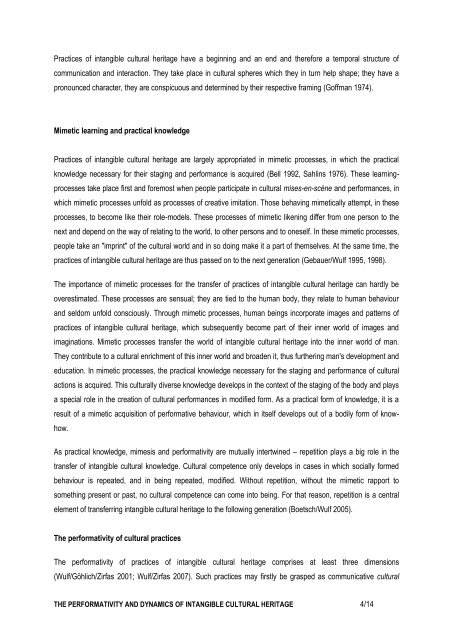the performativity and dynamics of intangible cultural heritage
the performativity and dynamics of intangible cultural heritage
the performativity and dynamics of intangible cultural heritage
You also want an ePaper? Increase the reach of your titles
YUMPU automatically turns print PDFs into web optimized ePapers that Google loves.
Practices <strong>of</strong> <strong>intangible</strong> <strong>cultural</strong> <strong>heritage</strong> have a beginning <strong>and</strong> an end <strong>and</strong> <strong>the</strong>refore a temporal structure <strong>of</strong><br />
communication <strong>and</strong> interaction. They take place in <strong>cultural</strong> spheres which <strong>the</strong>y in turn help shape; <strong>the</strong>y have a<br />
pronounced character, <strong>the</strong>y are conspicuous <strong>and</strong> determined by <strong>the</strong>ir respective framing (G<strong>of</strong>fman 1974).<br />
Mimetic learning <strong>and</strong> practical knowledge<br />
Practices <strong>of</strong> <strong>intangible</strong> <strong>cultural</strong> <strong>heritage</strong> are largely appropriated in mimetic processes, in which <strong>the</strong> practical<br />
knowledge necessary for <strong>the</strong>ir staging <strong>and</strong> performance is acquired (Bell 1992, Sahlins 1976). These learning-<br />
processes take place first <strong>and</strong> foremost when people participate in <strong>cultural</strong> mises-en-scène <strong>and</strong> performances, in<br />
which mimetic processes unfold as processes <strong>of</strong> creative imitation. Those behaving mimetically attempt, in <strong>the</strong>se<br />
processes, to become like <strong>the</strong>ir role-models. These processes <strong>of</strong> mimetic likening differ from one person to <strong>the</strong><br />
next <strong>and</strong> depend on <strong>the</strong> way <strong>of</strong> relating to <strong>the</strong> world, to o<strong>the</strong>r persons <strong>and</strong> to oneself. In <strong>the</strong>se mimetic processes,<br />
people take an "imprint" <strong>of</strong> <strong>the</strong> <strong>cultural</strong> world <strong>and</strong> in so doing make it a part <strong>of</strong> <strong>the</strong>mselves. At <strong>the</strong> same time, <strong>the</strong><br />
practices <strong>of</strong> <strong>intangible</strong> <strong>cultural</strong> <strong>heritage</strong> are thus passed on to <strong>the</strong> next generation (Gebauer/Wulf 1995, 1998).<br />
The importance <strong>of</strong> mimetic processes for <strong>the</strong> transfer <strong>of</strong> practices <strong>of</strong> <strong>intangible</strong> <strong>cultural</strong> <strong>heritage</strong> can hardly be<br />
overestimated. These processes are sensual; <strong>the</strong>y are tied to <strong>the</strong> human body, <strong>the</strong>y relate to human behaviour<br />
<strong>and</strong> seldom unfold consciously. Through mimetic processes, human beings incorporate images <strong>and</strong> patterns <strong>of</strong><br />
practices <strong>of</strong> <strong>intangible</strong> <strong>cultural</strong> <strong>heritage</strong>, which subsequently become part <strong>of</strong> <strong>the</strong>ir inner world <strong>of</strong> images <strong>and</strong><br />
imaginations. Mimetic processes transfer <strong>the</strong> world <strong>of</strong> <strong>intangible</strong> <strong>cultural</strong> <strong>heritage</strong> into <strong>the</strong> inner world <strong>of</strong> man.<br />
They contribute to a <strong>cultural</strong> enrichment <strong>of</strong> this inner world <strong>and</strong> broaden it, thus fur<strong>the</strong>ring man's development <strong>and</strong><br />
education. In mimetic processes, <strong>the</strong> practical knowledge necessary for <strong>the</strong> staging <strong>and</strong> performance <strong>of</strong> <strong>cultural</strong><br />
actions is acquired. This <strong>cultural</strong>ly diverse knowledge develops in <strong>the</strong> context <strong>of</strong> <strong>the</strong> staging <strong>of</strong> <strong>the</strong> body <strong>and</strong> plays<br />
a special role in <strong>the</strong> creation <strong>of</strong> <strong>cultural</strong> performances in modified form. As a practical form <strong>of</strong> knowledge, it is a<br />
result <strong>of</strong> a mimetic acquisition <strong>of</strong> performative behaviour, which in itself develops out <strong>of</strong> a bodily form <strong>of</strong> know-<br />
how.<br />
As practical knowledge, mimesis <strong>and</strong> <strong>performativity</strong> are mutually intertwined – repetition plays a big role in <strong>the</strong><br />
transfer <strong>of</strong> <strong>intangible</strong> <strong>cultural</strong> knowledge. Cultural competence only develops in cases in which socially formed<br />
behaviour is repeated, <strong>and</strong> in being repeated, modified. Without repetition, without <strong>the</strong> mimetic rapport to<br />
something present or past, no <strong>cultural</strong> competence can come into being. For that reason, repetition is a central<br />
element <strong>of</strong> transferring <strong>intangible</strong> <strong>cultural</strong> <strong>heritage</strong> to <strong>the</strong> following generation (Boetsch/Wulf 2005).<br />
The <strong>performativity</strong> <strong>of</strong> <strong>cultural</strong> practices<br />
The <strong>performativity</strong> <strong>of</strong> practices <strong>of</strong> <strong>intangible</strong> <strong>cultural</strong> <strong>heritage</strong> comprises at least three dimensions<br />
(Wulf/Göhlich/Zirfas 2001; Wulf/Zirfas 2007). Such practices may firstly be grasped as communicative <strong>cultural</strong><br />
THE PERFORMATIVITY AND DYNAMICS OF INTANGIBLE CULTURAL HERITAGE 4/14


